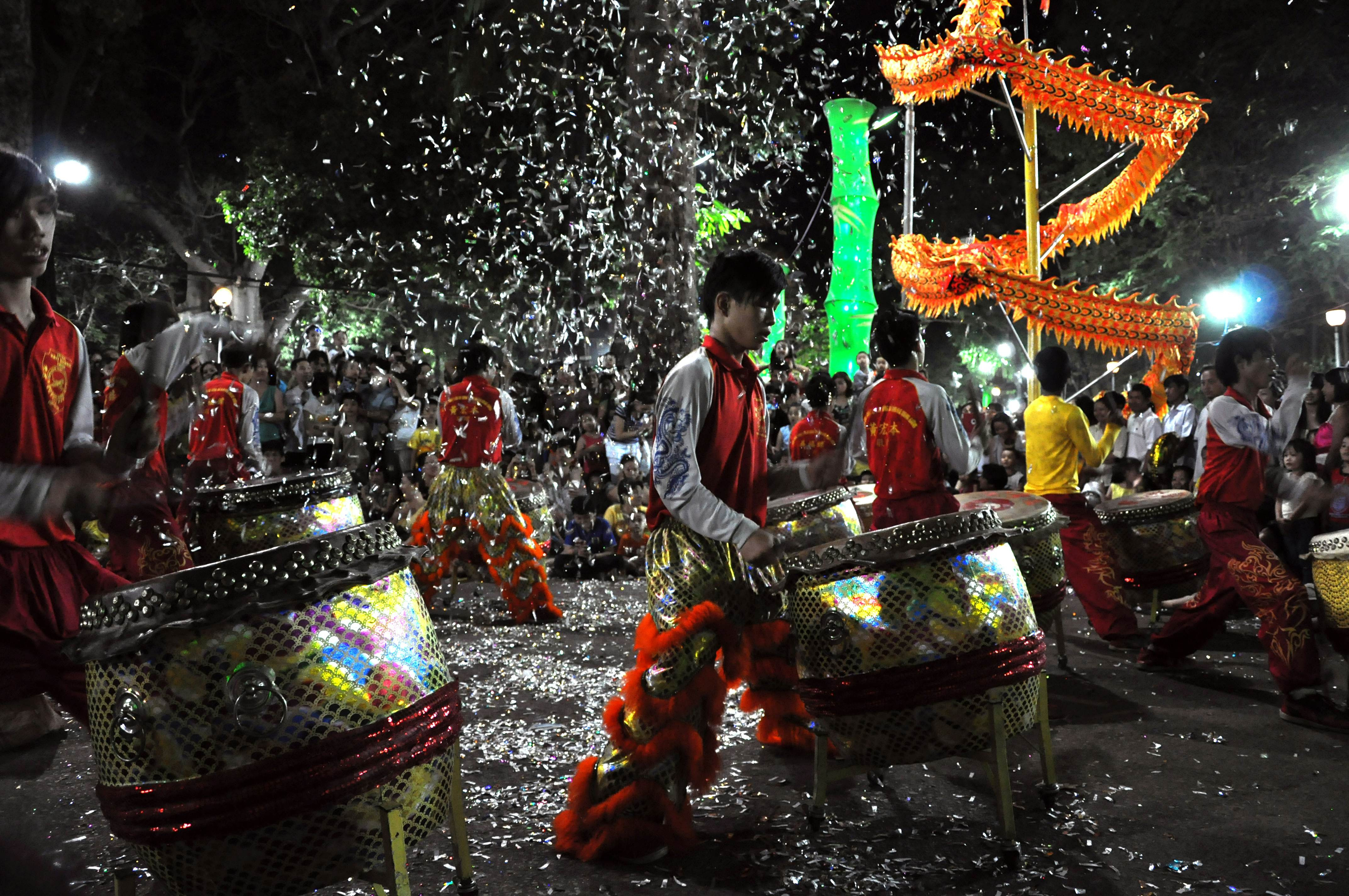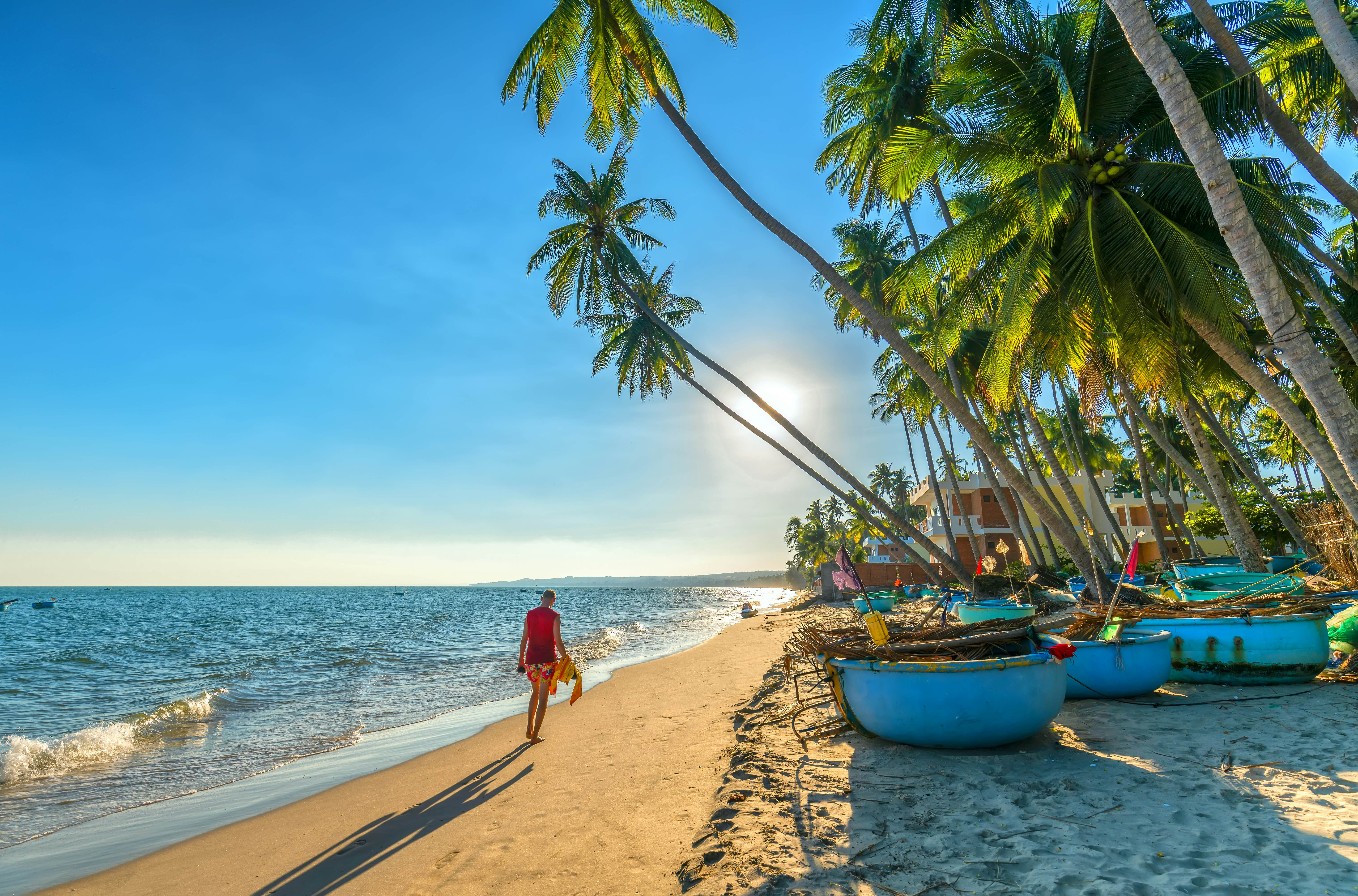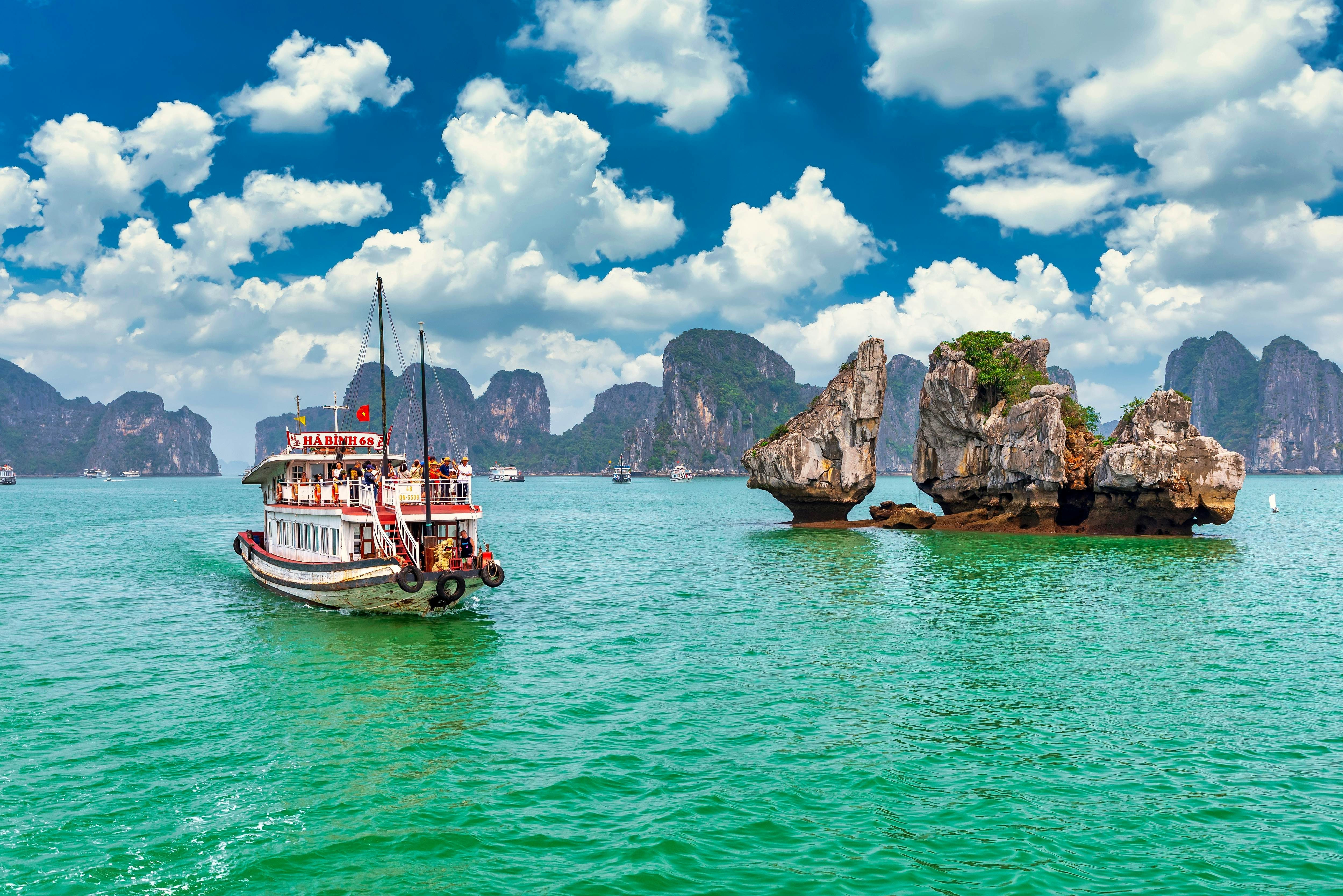Are you dreaming of a Vietnamese adventure but unsure about the ideal time to visit? Planning a trip to Vietnam requires considering the diverse weather patterns across the country. With SIXT.VN, you can navigate the best travel times and explore Vietnam’s stunning landscapes and vibrant culture with ease. Discover tailored travel advice and reliable services, ensuring an unforgettable journey through Southeast Asia, including transportation options and accommodations.
1. Understanding Vietnam’s Diverse Climate
Vietnam’s climate varies significantly from north to south, influencing the best time to travel. The northern region experiences a distinct winter and summer, while the south enjoys a tropical climate year-round. Knowing these variations is key to planning your perfect trip.
1.1. Northern Vietnam: Hanoi and Sapa
The north, including Hanoi and Sapa, has a four-season climate. Winter (December to February) can be chilly, especially in the mountains, with temperatures sometimes dropping to freezing in Sapa. Summer (May to August) is hot and humid with frequent rain.
- Best Time: October to April is ideal for visiting Hanoi, offering manageable temperatures and low humidity. For trekking in Sapa, October to March provides the best conditions, though December and January can be very cold at night. According to research from the Vietnam National Administration of Tourism in 2023, these months provide the best weather conditions for outdoor activities.
1.2. Central Vietnam: Danang and Hoi An
Central Vietnam, home to Danang and Hoi An, experiences hot, dry weather from February to May. The rainy season lasts from September to January, with potential for typhoons.
- Best Time: February to June is perfect for beach lovers, offering dry weather before the summer crowds arrive. This period aligns with favorable weather conditions for coastal activities, as highlighted in a 2022 report by TripAdvisor.
1.3. Southern Vietnam: Ho Chi Minh City and Phu Quoc
The south, including Ho Chi Minh City and Phu Quoc, has a tropical climate with a dry season (December to April) and a wet season (May to November). Temperatures remain consistently warm throughout the year.
- Best Time: December to March is excellent for visiting Phu Quoc, with clear skies and warm temperatures ideal for beach vacations. The dry season ensures pleasant conditions for exploring the Mekong Delta.
2. Peak Seasons vs. Off-Peak Seasons in Vietnam
Choosing between peak and off-peak seasons can greatly impact your travel experience in Vietnam. Peak seasons offer the best weather but come with larger crowds and higher prices. Off-peak seasons provide a more relaxed atmosphere and better deals, but may involve dealing with less predictable weather.
2.1. Peak Season: July and August
July and August are peak season, coinciding with summer holidays. Beach destinations like Danang and Nha Trang are particularly crowded, and prices for flights and accommodations can increase significantly.
- Pros: Favorable beach weather in central Vietnam.
- Cons: Crowds, higher prices, potential for rain in the north.
2.2. Shoulder Seasons: April to June and September to November
These months offer a balance, with fewer crowds and generally pleasant weather throughout the country. You might experience occasional rain, but also enjoy plenty of sunshine.
- Pros: Fewer tourists, lower prices, good for exploring the entire country.
- Cons: Unpredictable weather, occasional rain.
2.3. Low Season: May to September
The low season sees fewer tourists and the lowest prices, but also the highest chance of rain and typhoons, especially in the north and central regions.
- Pros: Budget-friendly travel, quieter attractions.
- Cons: Higher chance of rain, potential for travel disruptions due to storms.
3. Key Considerations for Planning Your Vietnam Trip
When planning your trip, consider your priorities: weather, budget, and crowd levels. Each season offers unique experiences and opportunities to explore Vietnam’s diverse attractions.
3.1. Weather Preferences
Do you prefer sunny beaches, cool mountain air, or mild city temperatures? Align your travel dates with the weather conditions that suit your interests.
- Beaches: February to June for central Vietnam, December to March for Phu Quoc.
- Trekking: October to March for northern highlands.
- City Exploration: December to April for Hanoi and Ho Chi Minh City.
3.2. Budget Considerations
Travel costs can vary significantly depending on the season. Peak season sees higher prices for flights, accommodations, and tours. Off-peak seasons offer better deals, but you might need to be flexible with your itinerary due to weather. According to a 2024 report by Booking.com, prices can fluctuate by up to 50% between peak and off-peak seasons.
3.3. Crowd Levels
If you prefer a more relaxed travel experience, avoid the peak season. Shoulder seasons offer a good balance between pleasant weather and fewer tourists.
- Quiet Getaways: April to June and September to November.
- Festivals and Events: Check local event calendars to experience Vietnam’s vibrant culture, but be prepared for larger crowds.
4. Detailed Monthly Guide to Traveling in Vietnam
Here’s a detailed monthly guide to help you decide the best time to visit Vietnam, considering weather patterns and major events.
4.1. January
- Weather: Cool and dry in the north, warm and dry in the south.
- Events: Tet Festival (late January/early February).
- Why Visit: Ideal for exploring Hanoi and Ho Chi Minh City, visiting Phu Quoc, and enjoying the Mekong Delta.
4.2. February
- Weather: Similar to January, with slightly warmer temperatures.
- Events: Tet Festival continues.
- Why Visit: Great for beaches in central Vietnam, exploring historical sites in Hue and Hoi An.
 Musicians playing drums during the Tet Lunar New Year celebrations in Ho Chi Minh City, Vietnam
Musicians playing drums during the Tet Lunar New Year celebrations in Ho Chi Minh City, Vietnam
4.3. March
- Weather: Warming temperatures throughout the country.
- Events: Buon Ma Thuot Coffee Festival.
- Why Visit: Good for trekking in the north, beach vacations in the south.
4.4. April
- Weather: Hotting up in the south, pleasant in the north.
- Events: Hue Festival (biennial, check dates).
- Why Visit: Ideal for exploring central Vietnam, enjoying cultural events.
4.5. May
- Weather: Hot and humid, with increasing rainfall.
- Events: Phat Dan (Buddha’s Birthday).
- Why Visit: Good for cultural experiences, exploring Ninh Binh.
4.6. June
- Weather: Hot and humid, with frequent rain.
- Events: Nha Trang Sea Festival (biennial), Danang Fireworks Festival.
- Why Visit: Enjoy beach festivals, explore coastal cities.
4.7. July
- Weather: Hot and sticky, with monsoon rains.
- Events: Danang Fireworks Festival.
- Why Visit: Beach vacations in central Vietnam, despite the crowds.
 Tourist walking underneath palm trees on the beach at Mui Ne, Vietnam
Tourist walking underneath palm trees on the beach at Mui Ne, Vietnam
4.8. August
- Weather: Hot and humid, with monsoon rains.
- Events: Trung Nguyen (Wandering Souls Day).
- Why Visit: Experience local festivals, explore pagodas in Ninh Binh.
4.9. September
- Weather: Transitioning from summer to winter, with decreasing rainfall.
- Events: National Day (September 2), Trung Thu (Mid-Autumn Festival).
- Why Visit: Ideal for avoiding crowds, exploring Hanoi during National Day.
4.10. October
- Weather: Mild temperatures, less rain.
- Events: Khmer Ok Om Bok Festival.
- Why Visit: Great for trekking in Sapa, exploring the Mekong Delta.
4.11. November
- Weather: Cool and dry in the north, warm and dry in the south.
- Events: Khmer Ok Om Bok Festival continues.
- Why Visit: Good for visiting Halong Bay, exploring the northern highlands.
 Boat cruises past karst outcrops in Halong Bay, Vietnam
Boat cruises past karst outcrops in Halong Bay, Vietnam
4.12. December
- Weather: Cool and dry in the north, warm and dry in the south.
- Events: Dalat Flower Festival, Christmas Day (Le Giang Sinh).
- Why Visit: Ideal for city exploration, visiting Phu Quoc, enjoying festive celebrations.
5. Navigating Vietnam’s Festival Seasons
Vietnam’s festivals are vibrant and culturally rich, but they can also mean larger crowds and higher prices. Planning around these events requires careful consideration.
5.1. Tet Nguyen Dan (Lunar New Year)
Tet is Vietnam’s most important festival, typically falling in late January or early February. It’s a time of family reunions, traditional customs, and nationwide celebrations.
- Impact: Expect significant travel disruptions, higher prices, and crowded attractions.
- Tips: Book accommodations and transportation well in advance, and be prepared for a festive but busy atmosphere.
5.2. Mid-Autumn Festival (Tet Trung Thu)
Celebrated in September or October, this festival focuses on children, with lantern parades, lion dances, and mooncakes.
- Impact: Increased local tourism, especially in cities like Hanoi.
- Tips: Enjoy the colorful celebrations, but book accommodations in advance.
5.3. Other Festivals
Numerous regional festivals occur throughout the year, offering unique cultural experiences.
- Hue Festival: A biennial arts and culture event held in April, May, or June.
- Nha Trang Sea Festival: A biennial beach festival held in June.
- Danang Fireworks Festival: An international pyrotechnics competition held in June or July.
6. Essential Packing Tips for Traveling to Vietnam
Packing appropriately for Vietnam’s climate and activities is crucial for a comfortable trip.
6.1. Clothing
- Lightweight and Breathable Fabrics: Essential for hot and humid weather.
- Rain Gear: Especially important during the rainy season.
- Warm Layers: For cooler temperatures in the northern highlands.
- Modest Clothing: For visiting temples and religious sites.
6.2. Footwear
- Comfortable Walking Shoes: For exploring cities and historical sites.
- Hiking Boots: If planning to trek in the mountains.
- Sandals or Flip-Flops: For beach vacations.
6.3. Other Essentials
- Sunscreen and Insect Repellent: Protect yourself from the sun and mosquitoes.
- First Aid Kit: Include necessary medications and basic medical supplies.
- Adapter: Vietnam uses Type A, C, and F plugs.
- Reusable Water Bottle: Stay hydrated and reduce plastic waste.
7. Exploring Vietnam with SIXT.VN: Your Travel Partner
SIXT.VN offers a range of services to enhance your travel experience in Vietnam, ensuring convenience and reliability.
7.1. Airport Transfers
Start your trip stress-free with SIXT.VN’s airport transfer service. Our professional drivers provide safe and comfortable transportation to your hotel.
- Benefits: Avoid taxi queues, fixed prices, reliable service.
- How to Book: Visit SIXT.VN, select your pickup location and destination, and choose your preferred vehicle.
7.2. Hotel Booking
Find the perfect accommodation with SIXT.VN’s hotel booking service. We offer a wide range of options to suit every budget and preference.
- Benefits: Competitive prices, verified reviews, easy booking process.
- How to Book: Browse hotels on SIXT.VN, filter by location, price, and amenities, and book securely online.
7.3. Tour Packages
Discover Vietnam’s highlights with our curated tour packages. From Halong Bay cruises to Mekong Delta explorations, SIXT.VN offers unforgettable experiences.
- Benefits: Expert guides, well-planned itineraries, hassle-free travel.
- How to Book: Explore tour options on SIXT.VN, select your preferred itinerary, and book online or contact our customer service team.
7.4. Flight Booking
Find the best deals on flights to Vietnam with SIXT.VN’s flight booking service. We compare prices from multiple airlines to ensure you get the best value.
- Benefits: Competitive prices, easy comparison, secure booking.
- How to Book: Enter your travel dates and destination on SIXT.VN, compare flight options, and book your tickets online.
8. Tips for First-Time Travelers to Vietnam
For first-time visitors, Vietnam can be an exciting but sometimes overwhelming destination. Here are some helpful tips to ensure a smooth and enjoyable trip.
8.1. Visa Requirements
Make sure you understand the visa requirements for your nationality before you travel. Many nationalities can enter Vietnam visa-free for a certain period, while others may need to apply for an e-visa or a visa on arrival. Always check the latest regulations on the official website of the Vietnam Immigration Department.
8.2. Currency and Payment
The official currency is the Vietnamese Dong (VND). While credit cards are accepted in larger establishments, it’s always a good idea to carry cash, especially when visiting local markets or smaller shops. ATMs are widely available in cities and tourist areas. According to a 2023 report by the State Bank of Vietnam, cash transactions still dominate, accounting for about 70% of all payments.
8.3. Local Customs and Etiquette
Respecting local customs can greatly enhance your experience. Dress modestly when visiting religious sites, remove your shoes before entering someone’s home, and avoid public displays of affection. Bargaining is common in markets, but do so politely and with a smile. Learning a few basic Vietnamese phrases can also be helpful and appreciated by locals.
8.4. Transportation
Getting around Vietnam is relatively easy, with various options available. In cities, taxis and ride-hailing apps like Grab are convenient. For longer distances, consider buses or trains. Domestic flights are also a good option for saving time when traveling between regions.
8.5. Food and Drink
Vietnamese cuisine is one of the country’s biggest attractions. From pho to banh mi, there’s a wide range of delicious dishes to try. Be adventurous but also cautious. Eat at reputable establishments or street vendors with high turnover to ensure food safety. Drink bottled water and avoid ice in rural areas.
9. Overcoming Travel Challenges in Vietnam
Like any destination, Vietnam presents certain challenges that travelers should be prepared for.
9.1. Language Barrier
While English is spoken in tourist areas, communication can be difficult in more remote regions. Learning a few basic Vietnamese phrases can be helpful. Consider using translation apps or hiring a local guide.
9.2. Traffic and Transportation
Traffic in Vietnamese cities can be chaotic, especially during rush hour. Be cautious when crossing streets and consider using ride-hailing apps for safer transportation. Always wear a helmet when riding a motorbike.
9.3. Scams and Tourist Traps
Like any popular tourist destination, Vietnam has its share of scams and tourist traps. Be wary of overly friendly strangers, always negotiate prices before agreeing to a service, and avoid unlicensed tour operators.
9.4. Health and Safety
Consult your doctor about necessary vaccinations and health precautions before traveling to Vietnam. Drink bottled water, use insect repellent, and avoid swimming in contaminated water. Purchase travel insurance that covers medical emergencies.
10. Frequently Asked Questions (FAQs) About When to Travel to Vietnam
10.1. What is the best time to visit Vietnam for good weather?
The best time for good weather is during the dry season, from December to April. This period offers pleasant temperatures and low rainfall, making it ideal for exploring the entire country.
10.2. When should I avoid traveling to Vietnam?
Avoid traveling during the typhoon season (August to September) due to the risk of storms and flooding, particularly in coastal areas.
10.3. Is it okay to visit Vietnam during the rainy season?
Yes, but be prepared for frequent rain. The rainy season (May to November) offers lower prices and fewer crowds, but you’ll need to pack accordingly.
10.4. What is the best time to visit Hanoi?
The best time to visit Hanoi is from October to April, offering manageable temperatures and low humidity.
10.5. When is the best time to visit Ho Chi Minh City?
The best time to visit Ho Chi Minh City is from December to April, during the dry season.
10.6. What is the best time to visit Phu Quoc for a beach vacation?
December to March is the perfect time for a beach vacation in Phu Quoc, with clear skies and warm temperatures.
10.7. When is Tet (Lunar New Year) celebrated in Vietnam?
Tet is usually celebrated in late January or early February, marking the start of the Vietnamese lunar New Year.
10.8. What are the benefits of traveling to Vietnam during the off-peak season?
Traveling during the off-peak season offers lower prices, fewer crowds, and a more relaxed travel experience.
10.9. How does the weather vary across different regions of Vietnam?
The north experiences a four-season climate, the central region has a distinct wet and dry season, and the south enjoys a tropical climate year-round.
10.10. What should I pack for a trip to Vietnam?
Pack lightweight clothing, rain gear, comfortable walking shoes, sunscreen, insect repellent, and any necessary medications.
Planning the perfect trip to Vietnam depends on your preferences and priorities. Whether you’re seeking sunny beaches, cultural festivals, or mountain adventures, understanding Vietnam’s diverse climate and seasonal variations is key. Let SIXT.VN be your trusted travel partner, providing reliable services and expert advice to ensure an unforgettable journey.
Ready to explore Vietnam? Visit SIXT.VN today to book your airport transfer, hotel, tour, or flight, and start planning your dream vacation. Contact us at Hotline/WhatsApp: +84 986 244 358 or visit our office at 260 Cau Giay, Hanoi, Vietnam for personalized assistance.



